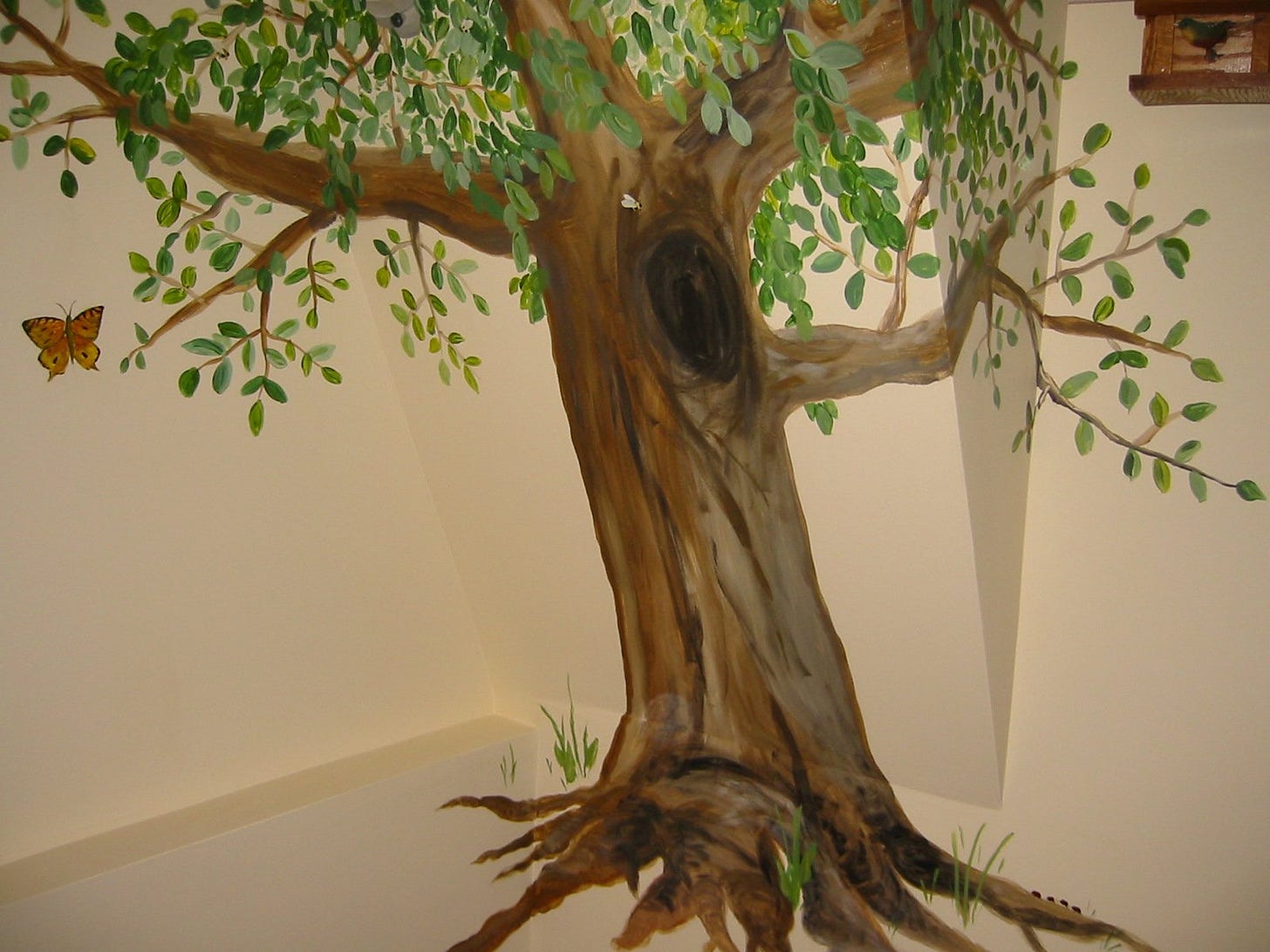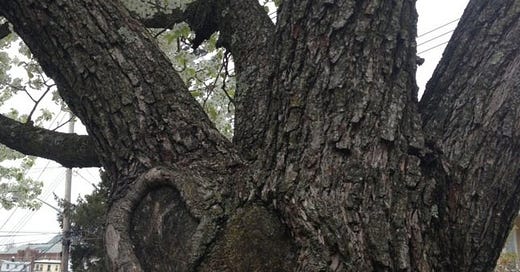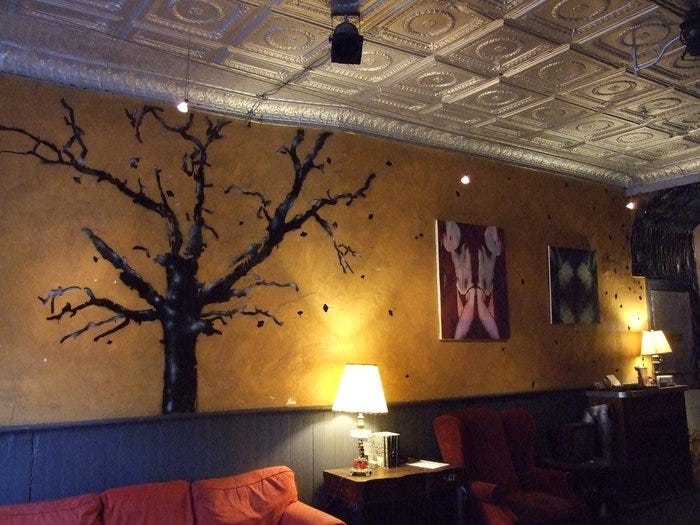The overall color we associate with botany is green. Green for leaves on trees, for bright new buds, for photosynthesis, for chlorophyll.
Pair this with blue sky and water and you have the optimum conditions for human serenity. Scientists have studied whether being near green (flora) or blue (flow) is more preferable for its mental health benefits and come up with blue slightly edging out green, or too close to call. Ideally, you can have it all: get a patch of forest for your campsite in a mountain valley along a lake and you have arrived at the bliss point of the spectrum. The lake surface of blue is rarely actually blue but reflects what’s in and around it, which around here in spring and summer is green, or evergreen all the time.
But green, remember from the biology of eyeballs, is only the unabsorbed color, the refuse, the only one returned to our tilted, translated internal perception. We think of green as the ultimate color of plant life teeming with health and growth and sugar, but The Hidden Life of Trees’ author Peter Wohlleben reminds us it’s quite the opposite. The materials of these machinations are everything but green—green is only what’s left. But nonetheless we gravitate to this teeming green and I especially to the ceaseless darker green of the evergreen forest, appreciating the way the old needles form a carpet and the tight canopy keeps the floor otherwise uncluttered.
On my new Catskills parcel, a young forest finding its footing after however many years of servitude as farmland (evidenced by the zag of the stone walls), there are pockets of sun spurring the weedier growth that comes along with that, alongside darker browner pockets under tree cover. I try, mostly unsuccessfully as they are so very stubborn—toddlers having tantrums—to unroot from my patch the tiny maples and oak babies that find their way regardless, to make way for the preferred varieties of spruce I’m planting instead. And I feel guilty for my preference and my clumsy attempt to, if not uproot, at least delay these unwanted saplings with cruel cuts.
I always feel the most amount of serenity, if possible to measure such a thing, in a quiet forest of conifers. But Peter suggests that many less established evergreen forests tend to be struggling more generally, are more stressed, and therefore impart more of that feeling to humans when we are in an evergreen forest doing our Shinrin-yoku (forest-bathing) pilgrimages. Being in a the midst of a stressed forest might actually raise, not lower, your heart rate.
For we might be sensitive to the sensitivity of trees.

Here I am hiding in my treehouse with my tree book surrounded by tree sprouts and my perceived green while the world mocks Trump and his squeaky tank birthday “perade” juxtaposed against the millions protest-marching across the map. I don’t feel this is a frivolous escape or off-topic if it’s meant to keep me intact. The things our no-king doesn’t care about are the very things I want to most protect and cherish. (I will write more about my opting out of the march another time.)
When I spent some recent weeks defining and then blurring the line between “intelligence” and “artificial” between man and machines, I think now we can further fuzzy with trees in the mix, trees that might be almost animal, trees that can breathe, that feel pain, share knowledge, help others, remember. We take these grand beings for granted because they live on a different scale, built into the landscape, seemingly simple and stable. They play a long game. Lumbering slow as a tortoise or a bowhead whale. We think we know everything there is to know about them with a glance, yet under the bark and underground they are so much more complicated than we give them credit for. We see trees as an object, an outline, we use them as a product. Paper, firewood, furniture, the scaffolding for my treehouse. But there’s a tree rubbing against the edge of my porch when the wind blows, chafing through the bark, and it seems to cringe in discomfort when I’m trying to sleep.
Can’t see the forest from the trees? In The Hidden Life, Peter writes:
A tree is not a forest. On its own, a tree cannot establish a consistent local climate. It is at the mercy of wind and weather. But together, many trees create an ecosystem that moderates extremes of heat and cold, stores a great deal of water, a generates a great deal of humidity. And in this protected environment, trees can live to be very old. To get to this point, the community must remain intact no matter what. If every tree were looking out only for itself, then quite a few of them would never reach old age. Regular fatalities would result in many large gaps in the tree canopy, which would make it easier for storms to get inside the forest and uproot more trees. The heat of summer would reach the forest floor and dry it out. Every tree would suffer.
Every tree, therefore, is valuable to the community and worth keeping around for as long as possible. And that is why even sick individuals are supported and nourished until they recover.
Can we as a country mimic not the solitary tree in the park who stands alone in its struggle (and dies much younger), but admire the kind and successful socialism of the forest. This is not a bad word, caring for one another; we can learn to grow a better way to live…longer, happier, healthier.
Once you read this book you might think trees are superior beings, or at least operating on a different plane. Among other ways they can communicate: by scent! Defensive compounds that smell and/or taste bad are released when a hungry caterpillar, for instance, takes a bite out of a leaf. The tree registers the pain of this attack, sending an electrical signal that travels not in milliseconds like a human nerve ending can fire but at a third of an inch per minute. (Everything measured on a different scale when you live to hundreds and not dozens of years.). A scent compound (delivered eventually—in an hour) can fend off an attack. A tree, writes Peter, can identify the saliva of a certain pest, so this means they also must have taste. They carry their own defenses, such as oak with its “bitter, toxic tannins in their bark and leaves.”
Tree roots, if given the space they need, want to, and will, spread more than twice as big as the crown, the roots will intersect with those from other trees, and secretly in this underworld, they will entwine and support each other. Fungi continue connections where the trees can’t,
operat[ing] like fiber-optic Internet cables. Their thin filaments penetrate the ground, weaving through it in almost unbelievable density. One teaspoon of forest soil contains many miles of these ‘hyphae.’ Over centuries, a single fungus can over many square miles and network an entire forest. The fungal connections transmit signals from one tree to the next, helping the trees exchange news about insects, drought, and other dangers.
This complex endless “wood wide web” runs across species, even connecting competitors.
Add to their communications olfactory, gustatory, visual and electrical—auditory. They emit sound. Maybe I am hearing screams of tree pain in the night of my treehouse and not just being dramatic. Scientists’ “measuring apparatus was registering roots crackling quietly at a frequency of 220 hertz.” Crackling quietly! In turn, the roots of seedlings responded, “orienting their tips in that direction” (i.e. toward the crackling.)
Peter debunks most of our mythology about the industry of planting trees, and how we think species need to be separated, or that they should ideally be isolated in neat rows by however much space. Rather, huddling close for growth is natural. The trees protect each other in groups as we read above. And oh these poor maple saplings who cling so stubbornly to their hard-won dirt-patch: so much effort went into their procreation—it was planned a year in advance, how and where the seed travels (flying on its own wings or with a bird or squirrel) or landing right below and experiencing over many years the long migration as patches of trees inch onwards into better conditions.
New trees have the tendency to grow too fast on their own given too much sunlight. A covered forest letting in less of this low light is healthier and better paced. Fast growth means means the new tree might be forming too much empty space in their cells that leaves room for infection. Steady wins the race.
Flood trouble? Erosion? Of course we know roots might help gird the soil, but also consider how much a tree can drink, how it might consume those gallons of rain that have no where to go otherwise beyond washing out the road or your house. Mature trees can contain more than 130 gallons of water through branches and leaves, assuming there’s that much to siphon from below. This heavy drinking habit isn’t sustainable year round, so the tree requires rest. It hibernates in winter, when the waters freeze within it. And back to the idea of tree noises that really tugs at me:
“When trees are really thirsty, they begin to scream.”
If you’re out in the forest, you won’t be able to hear them, because this all takes place at ultrasonic levels… vibrations occur[ing] in the trunk when the flow of water from the roots to the leaves is interrupted. This is a purely mechanical event and it probably doesn’t mean anything. And yet?
We know how the sounds are produced, and if we were to look through a microscope to examine how humans produce sounds, what we would see wouldn’t be that different: the passage of air down the windpipe causes our vocal cords to vibrate. When I think about the research results, in particular in conjunction with the crackling roots I mentioned earlier, it seems to me that these vibrations could indeed be much more than just vibrations—they could be cries of thirst. The trees could be screaming out a dire wire to their colleagues that water levels are running low.
Ultimately the tree’s greatest function is as a huge water pump, and like us this is all housed in this sensitive skin, an organ in its own right.
“A break in its bark, then, is at least as uncomfortable for a tree as a wound in our skin is for us.”
Roots run wild like the networks of our complicated neurons firing. Peter proposes that
brain-like structures can be found at root trips. In additional to signaling pathways, there are also numerous systems and molecules similar to those found in animals.
In truth, what is the difference between animal and vegetable, he ponders.
These findings
threaten to blur the boundary between plants and animals. And so what? What would be so awful about that? The distinction between plant and animal is, after all, arbitrary and depends on the way an organism feeds itself: the former photosynthesizes and the latter eats other living beings. Finally the only other big difference is in the amount of time it takes to process information and translate it into action. Does that mean that beings that live life in the slow lane are automatically worth less than ones on the fast track? Sometimes I suspect we would pay more attention to trees and other vegetation if we could establish beyond a doubt just how similar they are in many ways to animals.
And so I continue to reach out to touch the bark of my most beloved trees, petting them as if furred, waiting to detect a spark or a sound. We paint them, plant them, admire them, and can marvel in the mystery of how little we really understand their multi-sensory emissions and feelings. How so much lives under the surface, should we care to go deeper. How much we might have in common, scars and all.







❤️
Thank you for these tree musings, it was a really nice way to wake up to summertime.